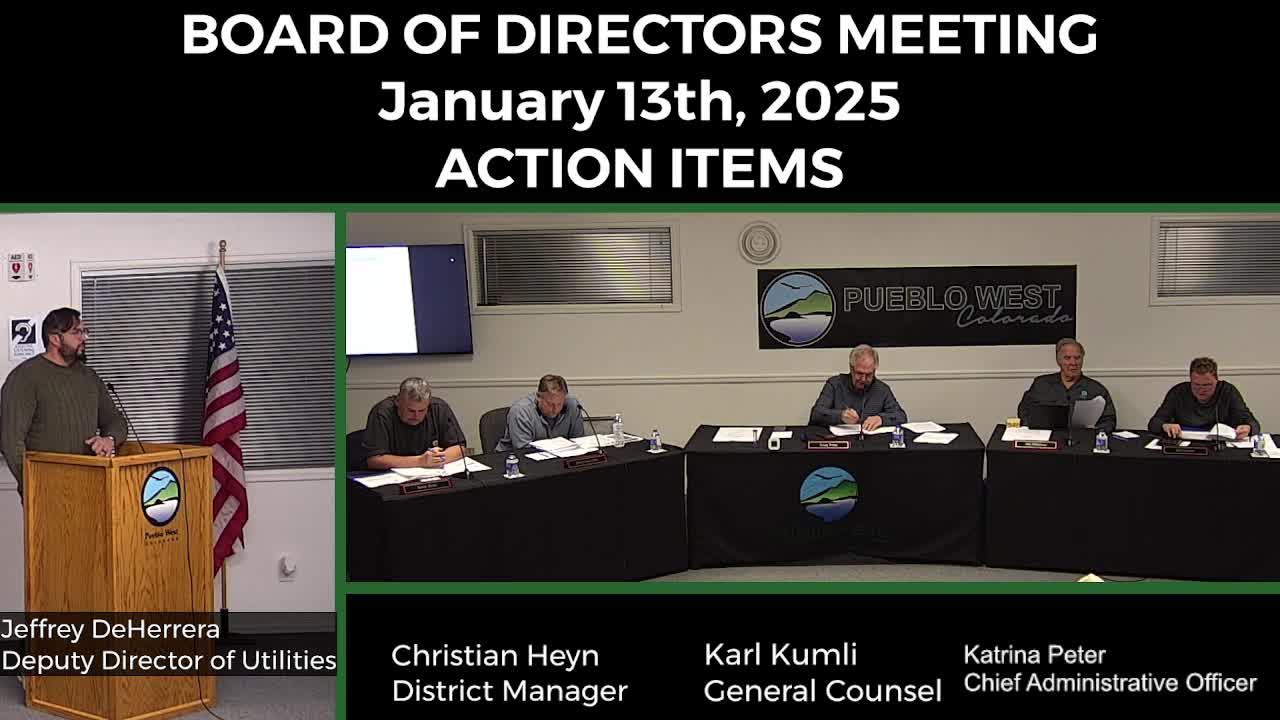Board approves SEH to design additional potable water tanks; staff say tanks could be phased and looping mains may reduce need
January 13, 2025 | Pueblo West, Pueblo County, Colorado
This article was created by AI summarizing key points discussed. AI makes mistakes, so for full details and context, please refer to the video of the full meeting. Please report any errors so we can fix them. Report an error »

The Pueblo West board authorized engineering design for potable water storage expansion at the North tank farm, approving Short Elliott Hendrickson (SEH) to provide design services after staff presented comparative scope options.
Deputy Utilities Director Jeffrey de Herrera said the district previously asked SEH to price design for one tank and also to price a package to design four tanks and demolition plans for existing infrastructure. De Herrera told the board SEH’s quoted fee to design one tank was about $198,702; the board approved the scope and fees to allow SEH to proceed with design work for additional tanks.
Board members questioned the rationale for designing multiple tanks if construction funding might come years later. Director Ward asked whether it makes sense to design four tanks if the district cannot afford construction until about 2028; De Herrera replied that construction likely would not happen until about 2028 in his view, and that design for multiple tanks preserves future options and could be reused if schedules slip. He also said tank designs would be similar across the North farm and to potential west‑end tanks, with site-specific differences such as soils and foundation design.
The board discussed alternatives: staff noted water modeling indicates upsizing certain mains and creating loops (for example around McCulloch) could improve flow and might obviate the need for a west‑end tank if main upsizes were done instead. That alternative would require less storage but more transmission-work trade-offs; staff emphasized both approaches would be evaluated during design.
Why this matters
More storage improves supply resiliency and supports future growth; the approved design work gives the district engineering-level plans to estimate construction costs, develop phasing scenarios, and seek financing if the board elects to build tanks in the coming years.
Next steps
Staff will finalize and execute the professional‑services agreement with SEH and provide a design schedule and deliverables to the board. Board members asked staff to return with estimated construction timelines, financing options and potential costs for phased construction.
Deputy Utilities Director Jeffrey de Herrera said the district previously asked SEH to price design for one tank and also to price a package to design four tanks and demolition plans for existing infrastructure. De Herrera told the board SEH’s quoted fee to design one tank was about $198,702; the board approved the scope and fees to allow SEH to proceed with design work for additional tanks.
Board members questioned the rationale for designing multiple tanks if construction funding might come years later. Director Ward asked whether it makes sense to design four tanks if the district cannot afford construction until about 2028; De Herrera replied that construction likely would not happen until about 2028 in his view, and that design for multiple tanks preserves future options and could be reused if schedules slip. He also said tank designs would be similar across the North farm and to potential west‑end tanks, with site-specific differences such as soils and foundation design.
The board discussed alternatives: staff noted water modeling indicates upsizing certain mains and creating loops (for example around McCulloch) could improve flow and might obviate the need for a west‑end tank if main upsizes were done instead. That alternative would require less storage but more transmission-work trade-offs; staff emphasized both approaches would be evaluated during design.
Why this matters
More storage improves supply resiliency and supports future growth; the approved design work gives the district engineering-level plans to estimate construction costs, develop phasing scenarios, and seek financing if the board elects to build tanks in the coming years.
Next steps
Staff will finalize and execute the professional‑services agreement with SEH and provide a design schedule and deliverables to the board. Board members asked staff to return with estimated construction timelines, financing options and potential costs for phased construction.
View full meeting
This article is based on a recent meeting—watch the full video and explore the complete transcript for deeper insights into the discussion.
View full meeting
